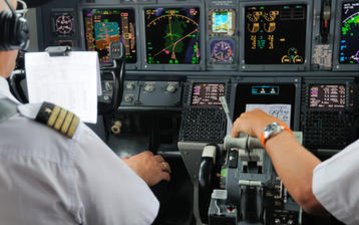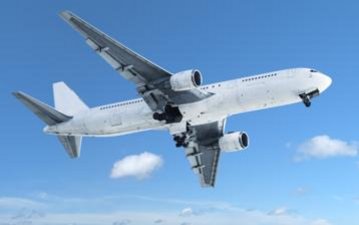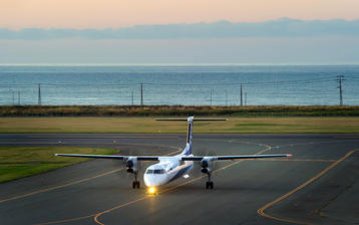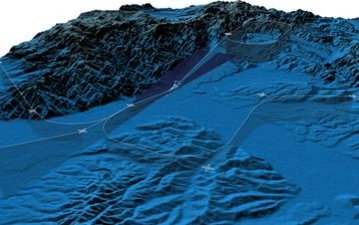Overview
Flight procedure design consists in the planning of routes used by pilots and air traffic control, from take-off to touchdown. These are designed to ensure that aircrafts maintain a minimum clearance over obstacles and terrain and have to meet further criteria such as aircraft performance limitations, airspace capacity and air traffic control separation requirements, as well as environmental concerns. The outcomes are charts used by pilots as well as coded procedures loaded into aircrafts' flight management systems (FMS).
The creation or revision of procedures is a complex and strictly regulated process, aiming to ensure the integrity of safety-critical aeronautical information.
airsight is an accredited flight procedure design organization and approved or recognized by several major civil aviation authorities. We provide our services in strict accordance to regulations and applicable quality standards (e.g. ISO 9001, ICAO Documents 9906 Quality Assurance, 8168 PANS-OPS, 9905 RNP AR Procedure Design Manual, etc.).
Flight Procedure Design
Design of conventional and RNAV/PBN instrument approach procedures, SIDs and STARs

airsight designs flight procedures according to ICAO PANS-OPS (Document 8168) taking into account several interdisciplinary constraints (such as safety, noise and capacity) as well as airspace configuration integration issues in coordination with ANSPs, aviation authorities, airports and airlines.
Based on the requirements/specifications by the client, the airsight will design the required flight procedures such as:
- Conventional instrument approach procedures (e.g. ILS, LOC, VOR)
- Performance-based navigation (PBN) instrument approach procedures (e.g. RNP APCH with LNAV, LNAV/VNAV or LPV Minima)
- SIDs & STARs
- ATS Routes (en-route phase of flight)
An iterative design process is expected to allow for incorporation of client’s requirements such as continuous climb and descent operations (CCO / CDO). The conceptual design is coordinated with the stakeholders involved. For the approved conceptual instrument flight procedures, the applicable design criteria are applied. The design criteria applied are the current international standards of the International Civil Aviation Organization, ICAO Doc 8168 (PANS OPS). If other design criteria need to be applied, such as national derivation from PANS-OPS criteria, those are coordinated with the stakeholders.
In order to ensure an efficient workflow and also to reduce potential human errors, advanced tools for flight procedure design such as FPDAM will be used.
If required aeronautical charts can be produced to support the flight validation (see Feasibility Studies) as well as publication within the AIP. The production of the aeronautical charts considers ICAO requirements (ICAO Annex 4, ICAO Doc 8697 Aeronautical Chart Manual).
The Quality Management System of airsight services is fully compliant with ICAO document 9906 „Quality Assurance Manual for Flight Procedure Design“. airsight’s flight procedure design services are certified ISO 9001:2015, as well as certified or recognised by several authorities.
Feasibility Studies
Expert support assessing the practicality of new or varied flight procedures at aerodromes

For demanding environments, it may be uncertain if (instrument) flight procedures can be implemented. Restriction may result from an obstacle rich environment and terrain, airspace issues or other reasons.
Before initializing the full IFP design process, airsight can support aerodromes and aircraft operators to assess the feasibility of implementing new flight procedures.
Different designs may be developed which can serve as the basis for further discussions with the other stakeholders.
Environmental Assessment of Flight Procedures
Optimization of flight procedures to meet eco-efficient targets

airsight offers the evaluation and environmental assessment of flight procedures (e.g. departures and approaches) with regards to aircraft noise, fuel efficiency and pollutant emission. As increased fuel efficiency goes hand in hand with reduced pollutant emissions, our goal is to find the optimum for eco-efficiency (noise and emissions) of flight procedures, meeting maximum acceptance for all involved stakeholders (airport and aircraft operators, ANSPs, authorities and the local communities).

Before new or modified instrument flight procedures can be published in the aeronautical Information publication (AIP), typically flight validation is required.
airsight can also offer to perform the validation process and as required the calibration.
Together with our partners flight validation can be carried out, ensuring:
- instrument flight procedures meet the intended operational requirement
- obstacle assumptions during the procedure design process are correct;
- pilot workload and flyability are acceptable;
- the air traffic environment is assessed;
- aeronautical charts and navigation database are checked.
Alternatively, a simulator-based flight validation may be carried out for performance-based navigation (PBN) flight procedures. The utilization of certified full flight simulators, where all parameters of various flight conditions can be recreated, by certified flight validation pilots ensure all requirements necessary are met.

Do you have a project that you'd like to discuss with us?
Send us a message, we will review your request and get back to you!






